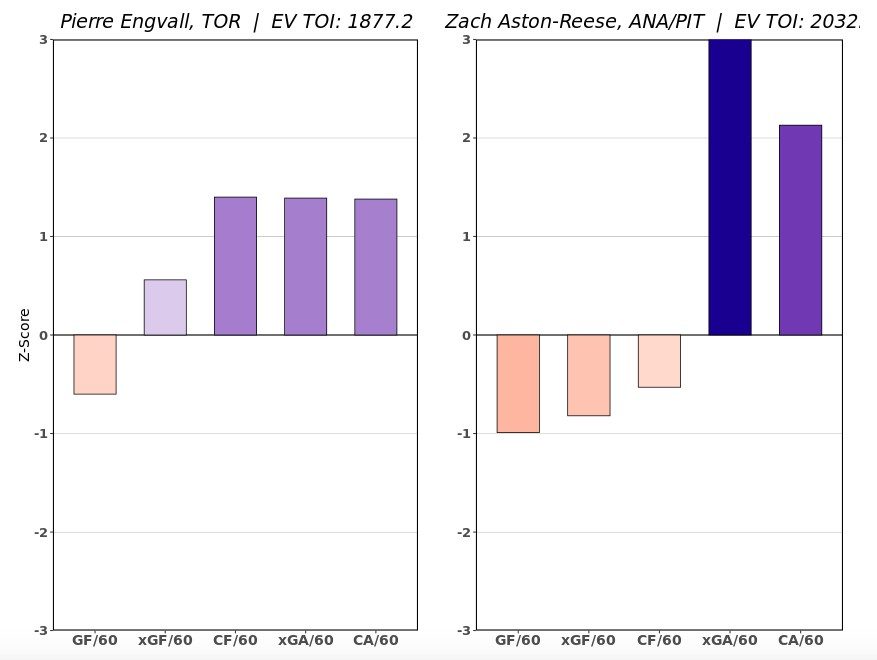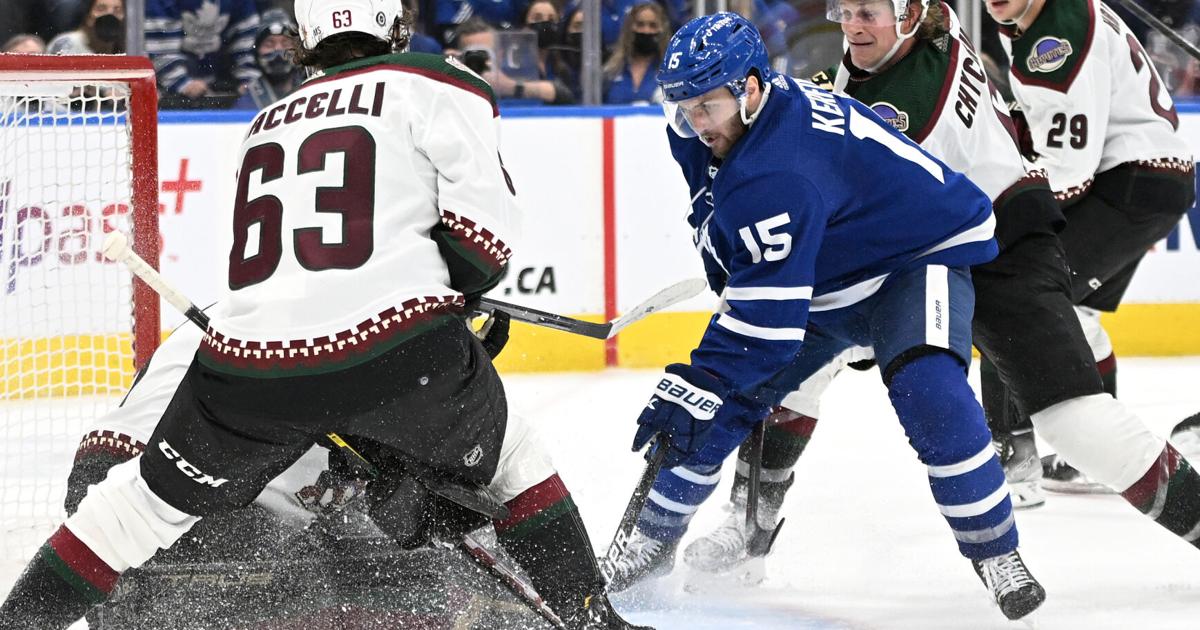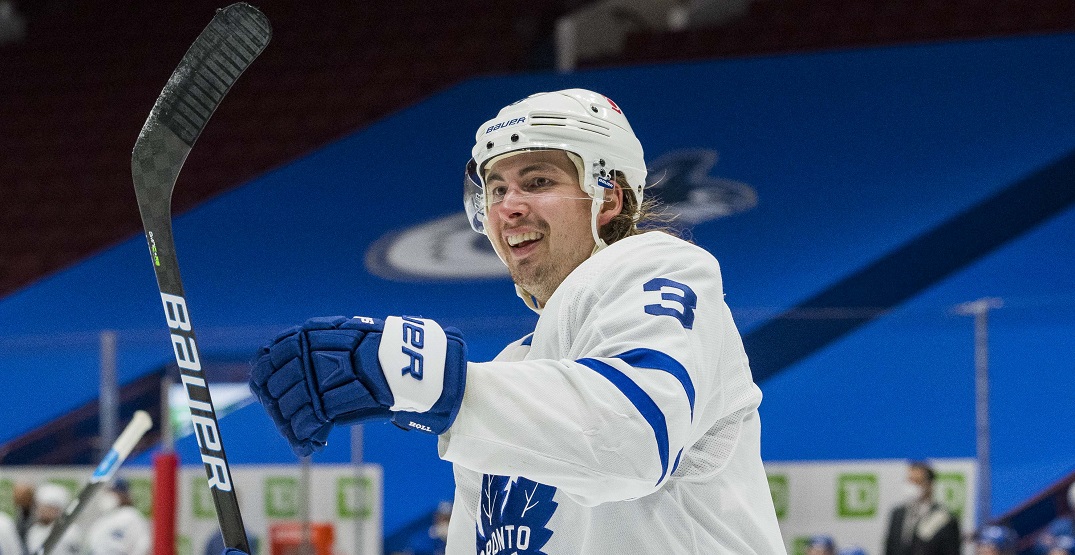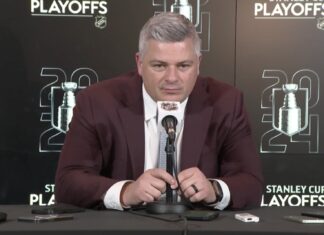The bulk of the NHL offseason is now over, but the Toronto Maple Leafs still have at least one more trade to complete.
The team is currently just about at the upper limit of the salary cap with Rasmus Sandin still to sign. There is little doubt that a trade will happen prior to the start of the season; it’s only a matter of when. While any player could be traded in theory, let’s not waste our time worrying about any potential blockbuster that has a 0.1% chance of happening.
Alex Kerfoot and Justin Holl, both set to hit the free agent market next offseason, are the most likely trade candidates. Jake Muzzin is another option, but he carries a full no-trade clause at the moment; the Leafs likely would have moved him already if they were going to go down that path. Pierre Engvall and his $2.25 million cap hit could also be traded, but he just signed earlier this month and the Leafs could certainly use his skillset following the loss of Ilya Mikheyev.
Sandin could even be traded — perhaps for a good young forward with plenty of potential — but those types of deals are quite rare. As I see it, Kerfoot and Holl have the best odds of moving by a significant margin.
As we examine Toronto’s cap situation, I’m making the following assumptions:
- The Leafs will use a 21-man roster. That gives them one spare in case of an injury or illness and will let them rest players like Mark Giordano and Jake Muzzin during the odd back-to-back situation.
- Toronto will want to give Nick Robertson a chance to make the team. Maybe he doesn’t make it out of camp, but they at least want to have enough cap space to have the option in case he plays well. They’ll also want to have the option to call him up midseason. I’ve put him on every roster iteration as a result, but you can replace him with one of Kyle Clifford, Joey Anderson, Denis Malgin, or Adam Gaudette if you’d like. Robertson makes about $50k more than the league minimum.
- The lines are not overly important for now. We can debate the best combinations another time. The league minimum forwards are pretty much interchangeable from a cap-hit perspective, so let’s not waste time worrying about whether it will be Robertson, Malgin, Gaudette, Anderson, or Clifford who will win the final spot.
Option One: Trade Kerfoot, Keep Holl
| LW | C | RW | LD | RD | G |
|---|---|---|---|---|---|
| Bunting | Matthews | Marner | Rielly | Brodie | Murray |
| Robertson* | Tavares | Nylander | Muzzin | Liljegren | Samsonov |
| Engvall | Kampf | Jarnkrok | Giordano | Sandin | |
| Simmonds | Aube-Kubel | Holl |
Cap Space Remaining (for Sandin + another forward): ~$3.47M.
Trading Kerfoot and keeping Holl gives you about $3.5 million for Sandin and another forward. We can bump that up to about $3.6 million if you replace Simmonds with Clifford. If Sandin signs a slightly more expensive two-year deal than Liljegren, you’re probably looking at $1.5 million to $2 million in cap space. That also assumes that the Leafs want to spend right up to the cap rather than banking more space for the deadline.
Both Jarnkrok and Engvall could shift over to center, so the new forward wouldn’t necessarily have to be a center. You could also use Gaudette or Malgin in place of Robertson or Simmonds to get around the positional need. Under this scenario, you might not be able to afford a free agent like Sonny Milano unless he takes a discount or Sandin takes a one-year deal. If they do trade Kerfoot, I’d like to see them add someone who can compete for a role on the Tavares line.
Option Two: Keep Kerfoot, Trade Holl
| LW | C | RW | LD | RD | G |
|---|---|---|---|---|---|
| Bunting | Matthews | Marner | Rielly | Brodie | Murray |
| Robertson* | Tavares | Nylander | Muzzin | Liljegren | Samsonov |
| Kerfoot | Kampf | Engvall | Giordano | Sandin | |
| Simmonds | Jarnkrok | Aube-Kubel | Benn |
Cap Space Remaining (for Sandin): ~$1.22M.
This scenario assumes that one of Jordie Benn or Victor Mete would make the team as the seventh defenseman. Both players make the league minimum. They’d have about $1.36 million if they swapped in Clifford for Simmonds, but that’s not quite enough for Sandin to match Liljegren’s $1.4 million cap hit. In this scenario, they may have to focus on a one-year deal for Sandin instead of two or more.
They could scrap the seventh defenseman and use a roster with no spares, which would give them just under $2 million for Sandin, or $2.1 million if they swapped in Clifford for Simmonds. However, it’s safe to assume they’ll want to have at least one extra player around for when they go on the road.
Trading Engvall rather than Holl would result in an extra $250k of cap space, assuming that we would be replacing Engvall with a minimum forward. I don’t think that’s likely to happen, but I suppose it’s possible if he’ll fetch a far better return than Kerfoot and Holl. If Sandin ends up taking a “prove it” one-year contract similar to a qualifying offer, keeping Kerfoot and trading Holl might be their final decision.
Option Three: Trade Kerfoot, Trade Holl
| LW | C | RW | LD | RD | G |
|---|---|---|---|---|---|
| Bunting | Matthews | Marner | Rielly | Brodie | Murray |
| Robertson* | Tavares | Nylander | Muzzin | Liljegren | Samsonov |
| Engvall | Kampf | Jarnkrok | Giordano | Sandin | |
| Simmonds | Aube-Kubel | Benn |
Cap Space Remaining (for Sandin + another forward): ~$4.72M.
Once again, this scenario assumes that one of Jordie Benn or Victor Mete would make the team as the seventh defenseman. They would have about $4.86 million if they swapped in Clifford for Simmonds, and they’d have the flexibility to re-sign Sandin to a multi-year deal.
Assuming that Sandin takes the same two-year term as Liljegren, my guess is that the Leafs would have close to $3 million to spend on a forward. If they scrapped the seventh defenseman and ran a roster with no spares, they’d have up to $3.7 million to spend (although you’re basically just swapping out Kerfoot for another $3.5 million forward at that point).
By doing this, the Leafs could probably afford someone like Sonny Milano. One of Jordie Benn or Victor Mete would get a chance to impress as a seventh defenseman, or the Leafs could end up trading for someone to fill that role such as Luke Schenn.
Option Four: Trade Kerfoot, Holl, and Engvall
| LW | C | RW | LD | RD | G |
|---|---|---|---|---|---|
| Bunting | Matthews | Marner | Rielly | Brodie | Murray |
| Tavares | Nylander | Muzzin | Liljegren | Samsonov | |
| Robertson* | Kampf | Jarnkrok | Giordano | Sandin | |
| Simmonds | Aube-Kubel | Benn |
Cap Space Remaining (for Sandin + two forwards): ~$7M.
This is a long shot, but it represents the maximum amount of cap space that the Leafs could realistically create without making a major trade (involving someone like Muzzin or Sandin). All three players have one year of term remaining before free agency, and it would be quite easy to move all of them (although you may not get an A+ return in every case). Essentially, if a great free agent or trade opportunity came their way, this is what they could do.
If we assume that Sandin gets $1.8 million, the team would have about $5.2 million to split between two forwards. If they inserted a league-minimum forward like Anderson or Gaudette for one of those spots, they’d be left with about $4.5 million or so for a top-six forward.
Players like Evan Rodrigues or Anthony Beauvillier should be able to fit in, and they could maybe even end up with a $5 million forward if Sandin took a one-year “prove it” deal. If we put in Clifford for Simmonds and scrapped the seventh defenseman, the Leafs would have $7.86 million for Sandin and two forwards.
Option Five: Keep Kerfoot, Trade Holl and Engvall
| LW | C | RW | LD | RD | G |
|---|---|---|---|---|---|
| Bunting | Matthews | Marner | Rielly | Brodie | Murray |
| Robertson* | Tavares | Nylander | Muzzin | Liljegren | Samsonov |
| Jarnkrok | Kampf | Aube-Kubel | Giordano | Sandin | |
| Kerfoot | Simmonds | Benn |
Cap Space Remaining (for Sandin + one forward): ~$3.47M.
The Leafs could sure use a good center option behind Matthews, Tavares, and Kampf. Keeping Kerfoot around would give Sheldon Keefe plenty of options for this role; both Jarnkrok and Kerfoot could fill this need. In an ideal world, one player looks like a perfect fit in the top nine and the other could play up the middle to drive their own line.
The question becomes: Would you rather keep Kerfoot or Engvall? Both players have one year of term remaining, so the long-term implications are minimal. Trading Kerfoot would free up $1.25 million more cap space, but the Leafs probably like Kerfoot more as a top-six winger or bottom-six center option. The potential trade return for both players may be quite similar.
Engvall graded out very well by Evolving Hockey’s RAPM last season, but Kerfoot brings to the table more playmaking ability, which Toronto’s bottom six could certainly use. If they trade Engvall, they’re probably looking for a good defensive forward to replace him such as Zach Aston-Reese or Tyler Motte. Personally, I think I’d then put that player with Kampf and Aube-Kubel on a checking line and create a third scoring line with Kerfoot and someone like Jarnkrok or Robertson.

If you’re worried about bottom-six scoring, keeping Kerfoot around might make sense. Trading Engvall would likely make the Kampf line more of a traditional fourth line that takes a ton of defensive zone starts and throws hits but doesn’t bring much to the table offensively. Engvall carries a lower cap hit than Kerfoot — he also doesn’t carry the same 10-team no-trade clause — so there are more suitors for him.
Best Trade Partners

Both Kerfoot and Holl are set to hit the free agent market next offseason. They each carry a 10-team no-trade list, although Holl might not be overly picky if the Leafs were to tell him that he’ll be a seventh defenseman on their roster. Kerfoot’s no-trade list is probably more firm.
Justin Holl: 1 x $2 million ($2 million in actual salary)
Most teams are set on the right side, so this is a shorter list than you’d expect. P.K. Subban is a free agent, while right-shooting defensemen like Nikita Zaitsev could be traded. Perhaps there is a team out there that loves Holl and makes a good offer for him, but given the market, I’m not expecting much of a return for him.
Washington is a fit if they prefer him over Trevor van Riemsdyk, but they’re weaker on the left side and should probably aim a bit higher. I’d ask about Garnet Hathaway, but Conor Sheary is probably more likely. Columbus is a fit if they prefer him over Andrew Peeke, but I’m guessing that they will keep what they have. Vancouver is a fit; I could see Luke Schenn ($850k cap hit) coming back the other way as a cheap seventh defenseman.
Chicago and Detroit could certainly use him, but he probably doesn’t want to go there and you probably wouldn’t get much back. Seattle could use him, but they could opt for a left-shooting defenseman instead. Ottawa is looking for help on the right side, but like Seattle, they might aim higher. They’d also likely want to trade one of Zaitsev or Hamonic first.
I’ll guess Vancouver (for Schenn) or Washington. I’m not expecting much here given the market. Assuming the Leafs trade Kerfoot, they may opt to keep Holl unless the right forward comes along.
On one hand, I think all six of Rielly, Brodie, Muzzin, Giordano, Liljegren, and Sandin need to play just about every night. On the other hand, I certainly have more confidence in Holl stepping into the lineup in a shutdown role compared to the average seventh defenseman. If Kerfoot is traded, moving Holl only makes sense if there’s a good $2.5 million to $3 million forward available that they like significantly more than the cheaper options.
Alex Kerfoot: 1 x $3.5 million ($750k in actual salary)
Kerfoot, who is set to earn the league minimum in terms of actual salary, should have some trade value following a 51-point season. Non-cap teams should value him more, but here’s the problem: Most of those teams are probably on his no-trade list. He’s also a one-year rental, so most rebuilding teams won’t want to part with any significant futures to acquire him.
If the Leafs trade Kerfoot, they should probably look to get creative here and send him to a third team that would retain part of his cap hit. Since his actual salary for next season is the league minimum, it wouldn’t cost a team much to retain and it could help a team like Anaheim or Arizona to reach the cap floor. The Leafs may need Kerfoot’s permission to move him to one of those teams, but if he’s simply getting flipped elsewhere, he probably wouldn’t care. I’m sure you could find some team to help out for a small fee.
At 50% retention, Kerfoot makes sense for just about every contender. However, unless a team in the East is giving them the best offer by a mile, Toronto probably doesn’t want to help them out. The Leafs could simply trade him for the best pick that they can get. They could stockpile draft picks to use at the trade deadline and then turn around and sign one of the remaining free-agent forwards to help replace him. If they do acquire an NHL player in return, I’d expect it to be someone with one year of term left.
Colorado already traded Kerfoot once, and they don’t have many picks left in future years. They’re probably aiming a little bit higher for their second-line center role, but I wouldn’t rule them out completely. Los Angeles has too many forwards as it is; while I’d ask them about Trevor Moore, that’s probably not the most likely option. I’d also ask about Cody Glass in Nashville, who don’t seem to be overly high on him.
If there isn’t a third term involved, Minnesota makes the most sense. They’re set in terms of goaltending and defense and could use an extra top-nine forward like Kerfoot. They have a major cap crunch coming next season, so they’re probably only looking for someone with one year of term. Kerfoot seems perfect for them, whether it’s for a pick or someone like Frederick Gaudreau (1 x $1.2M). Calgary is another great fit, as they could use a winger who can shift over to center if Monahan misses time again.


































